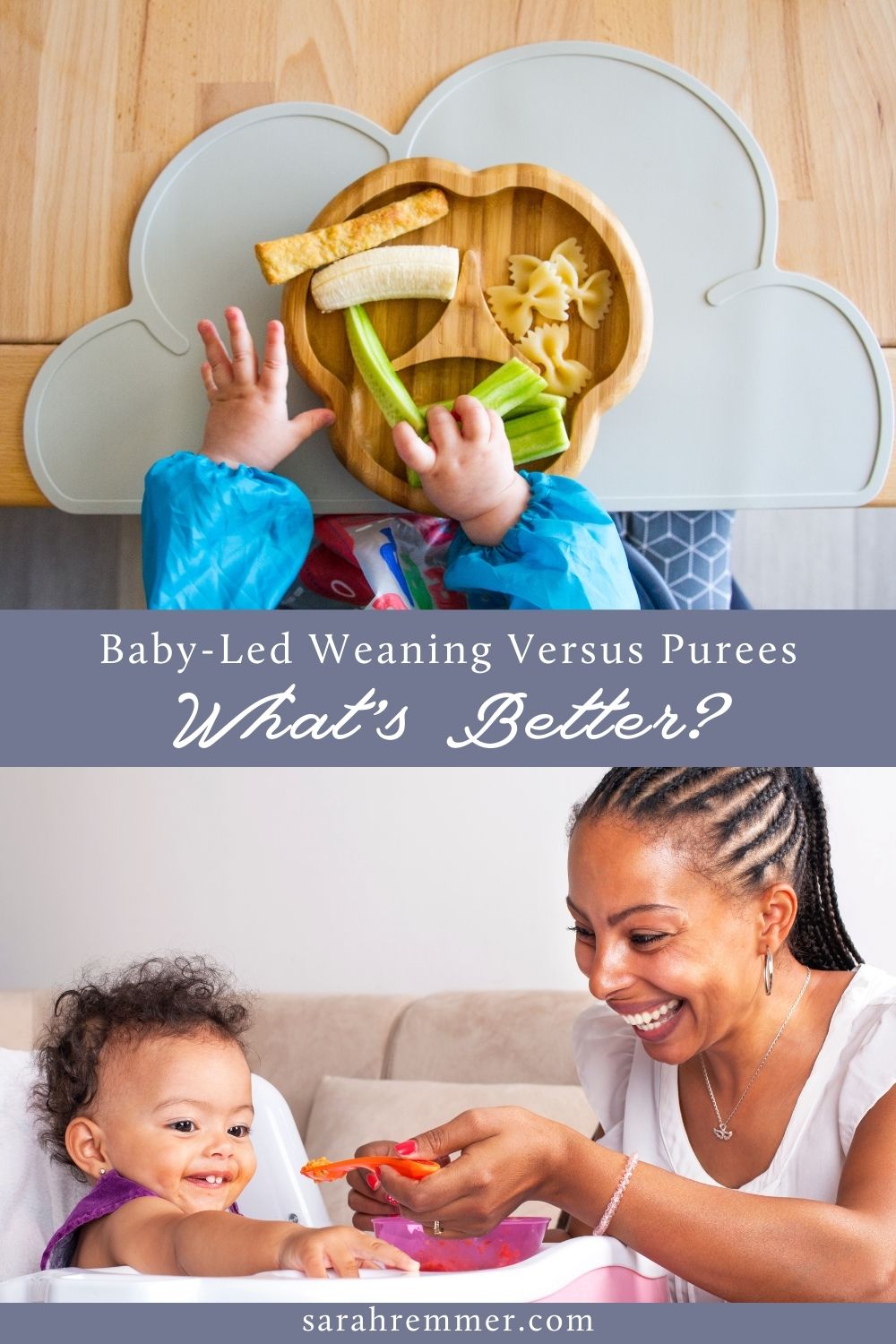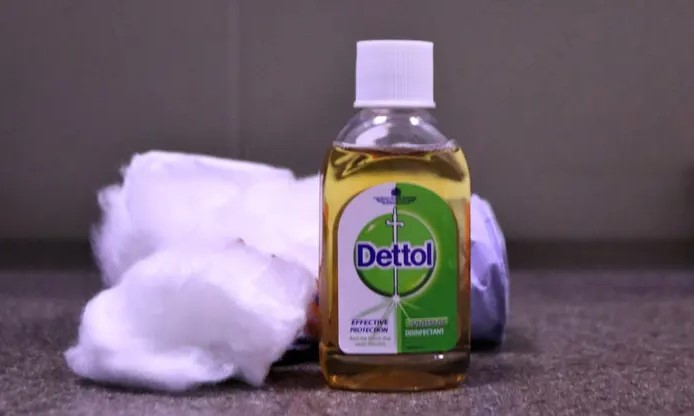Starting Solids: Baby-Led Weaning Versus Purees
Here is everything you need to know from a pediatric registered dietitian on whether to introduce baby to solids using purees, by doing baby-led weaning, or a combination, and why.

Introducing your baby to solids is one of the biggest milestones in your baby’s first year of life. The transition to solids foods is really exciting, but can also feel daunting for parents and caregivers (especially if it is your first baby!). When you add in the pressure of choosing HOW to do it or doing it “the right way”, it can feel more and more intimidating. The overload of conflicting information out there on how and when to start your baby on solids foods, as well as differing opinions from everyone, including doctors, parent, and friends may leave you feeling confused and anxious. That’s why, as a pediatric dietitian and mom, I’ve written this post that summarizes the latest evidence-based infant feeding guidelines, and helps you to navigate the journey of starting solids, anxiety free. Let’s get started!
Starting solids, the basics
You may be relieved to hear that you do not need to follow a strict plan of when, how much, or even how to feed your baby solids! It is important to trust your gut when deciding the feeding method that will work best for you and your little one. It is a good idea to minimize distractions and sit directly across from your baby as they eat. When introducing a new food, only add a small amount to the plate or spoon at first, as too much food can be overwhelming. By six months, most babies are ready for a variety of foods and textures ranging from thin purees to soft finger foods. One idea is to experiment with a variety of textures (such as purees, mashed, finely minced, ground, steamed or tender-cooked) and see what your baby prefers! You may notice that your baby starts to enjoy a wider variety of textures as their oral motor skills expand as the weeks go on!
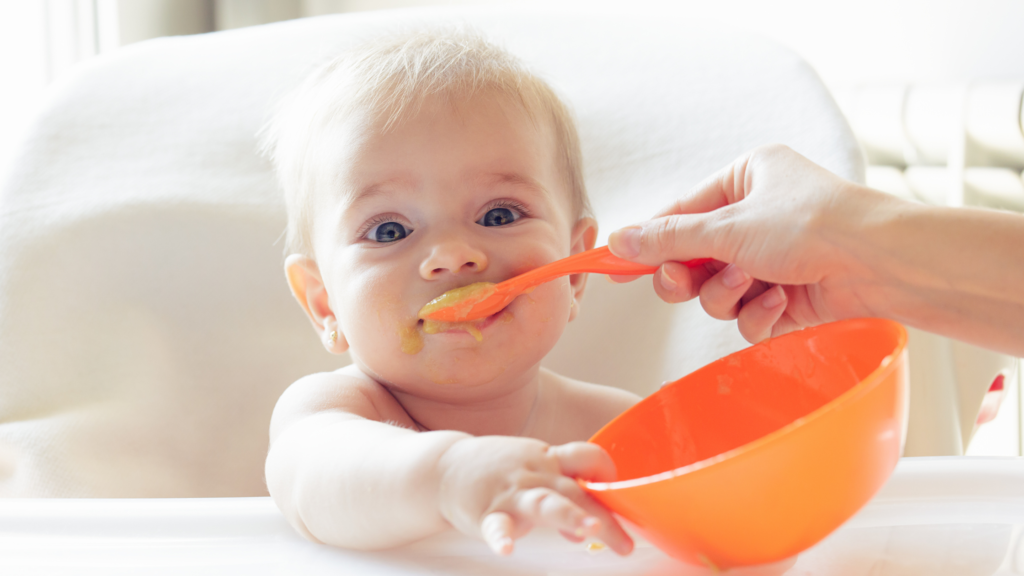
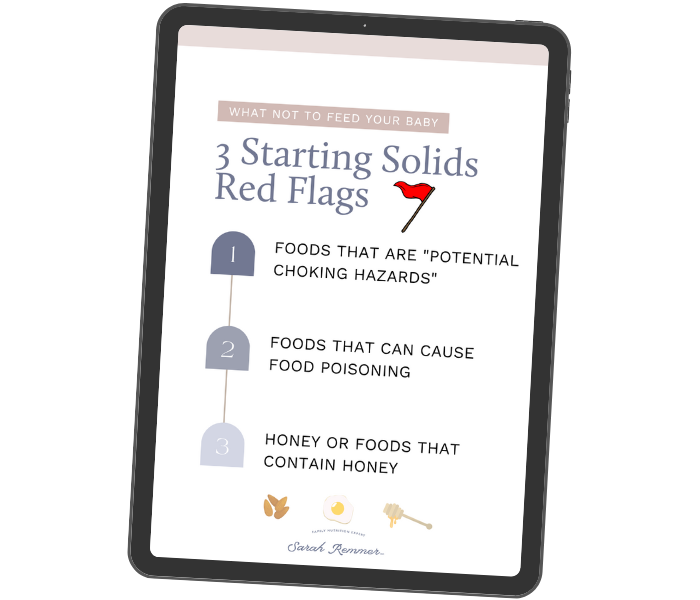
Starting solids? Don’t panic.
Starting solids is an exciting milestone in your baby’s life, but it can also be confusing, especially when you’re overloaded with conflicting information on how and when to do it. Download your free guide to starting solids and clear the confusion!
When you introduce solids DOES matter
No matter which method you choose to introduce solids, it is important that you are able to recognize your baby’s readiness cues before you decide to start their eating journey. Starting solids too early before your baby is developmentally ready can put them at risk for choking. Baby’s tiny tummy may not be ready to digest the nutrients in real food either. However, starting too late may make transition to foods more challenging with higher risk of picky eating issues. It can also put your baby at risk for iron-deficiency anemia. Give or take a couple weeks around 6 months of age is the “sweet spot” for starting solids unless otherwise advised by your baby’s pediatrician.
Signs that your baby is ready for solids
As mentioned above, all babies develop at different rates, so it is important to keep an eye out for the following signs of readiness:
- Able to sit minimally supported with good head and neck control, and can hold themselves up in a highchair.
- Will open their mouth when food comes their way. You will notice your baby seems interested in food and likes watching you eat.
- Able to reach out and grab items and bring them to their mouth.
- Can move food from a spoon to the back of their throat. Most of the tongue thrust reflex will be gone (where baby pushes food out of their mouth with their tongue).
- Is big enough. Has your baby doubled their birth weight or is at least 13lbs? If so, they may be ready to start solids!

What is the history of spoon feeding and baby led weaning?
Up until recently, spoon-feeding pureed foods to babies was the standard practice. The recommendation was to slowly progress from thin purees, to mashes, to eventually serving finger foods at around a year old. In 2001, Gill Rapley a former public health nurse, introduced the concept of Baby-Led Weaning. This sparked a shift in parents starting to offer soft-cooked finger foods right from the beginning. The concept was to let your child self-feed with their hands at their own pace, skipping the traditional spoon-feeding method altogether.
In 2015, Health Canada has since updated infant feeding guidelines stating that baby’s ability to manage and safely swallow solid foods develops at around 6 months. National nutrition guidelines now include safe, soft-cooked finger foods with less rules around introducing foods one at a time or delaying introduction of allergens. It is important to note there isn’t research that tells us you should choose one feeding method over the other. Baby-led weaning and spoon feeding each come with benefits! And what I recommend as a dietitian, is actually a combination of both! Keep reading to find out more details about each method.
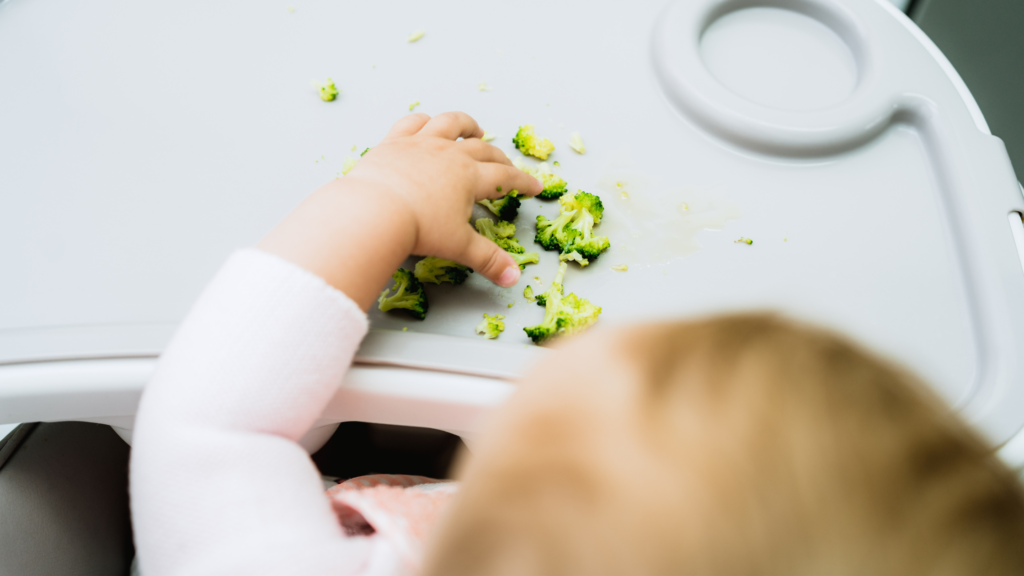
What is the traditional spoon feeding method of introducing solids?
With the traditional spoon-feeding method, all foods are cooked then pureed into a smooth texture to start (or parents can use store-bought purees too!). The parent or caregiver feeds baby the puree with a spoon at around 4-6 months of age when baby is ready (showing signs) to start solids. This feeding method moves from thin purees, to thicker mash, then to minced and finely chopped foods. Eventually finger foods are offered at around one year of age.
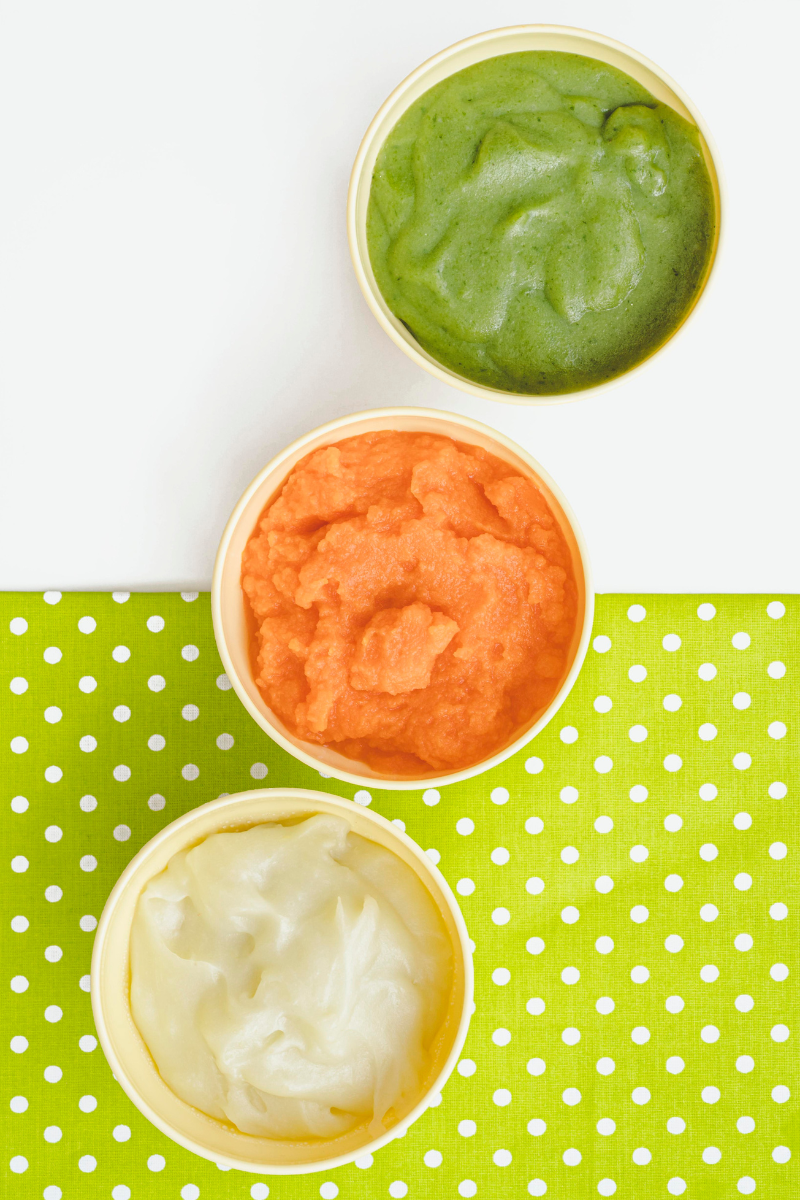
What is baby-led weaning?
Baby-Led Weaning, first introduced by Gill Ripley in 2001, involves preparing soft finger foods for baby to self-feed, as an alternative to the care-giver spoon-feeding purees. Parents or caregivers offer whole, soft and safe foods on babies tray (the same foods that the rest of the family are eating, unless they’re highly seasoned or have added sugar), and the baby brings those pieces of soft cooked foods (such as steamed broccoli trees) or finger-like shaped foods (such as longer-shaped meatballs or omelets cut into strips) to their mouth to eat independently.
This feeding method starts at around 6 months, with larger pieces of soft cooked foods that babies can easily grasp in their fist (with a grasp called the “palmer grasp”). As baby begins to develop better finger dexterity, at around 9 months, they may be ready to pick up smaller pieces of food with their fingers (called the “pincer grasp”). At this time, smaller pieces of soft food (such as raspberries or soft cooked pieces of meat) can be offered to baby to help them strengthen their pincer grasp. For more in depth information on baby-led weaning and how to start this process with your little one, read the Beginner’s Guide to Baby-Led Weaning.
So, what is better for starting solids, baby-led weaning or traditional spoon feeding?
Honestly, this is a really personal decision and there is no right or wrong! Personally, I recommend trying a combination of both methods! Baby-led weaning helps baby to learn how to self-regulate how much and how fast they eat. But what many parents don’t realize, is that traditional spoon feeding can also be baby-led! In fact, spoon feeding can provide an incredible bonding experience if it is done with awareness, with the parent honoring baby’s physical signs of hunger and fullness. No matter how you choose to feed your little one, as long as you are feeding responsively, and offering a variety of tastes and textures, you are doing a great job!
| SPOON FEEDING PROS | BABY LED WEANING PROS |
| – Unique bonding experience between baby and parent/loved one – Can experiment with a variety of nutritious homemade purees – A little bit cleaner than BLW – Baby learns to manipulate thinner smooth purees as well as thicker more textured purees in the mouth – Can be convenient to have a container of pureed food when out and about |
– Baby develops fine motor skills and learns to feed independently from an earlier age – Baby is 100% in control of how much and how fast they eat – Potentially reduces the risk of picky eating later on – Cuts down the cost of store-bought baby food – Baby gets to experience the same foods as the rest of the family |
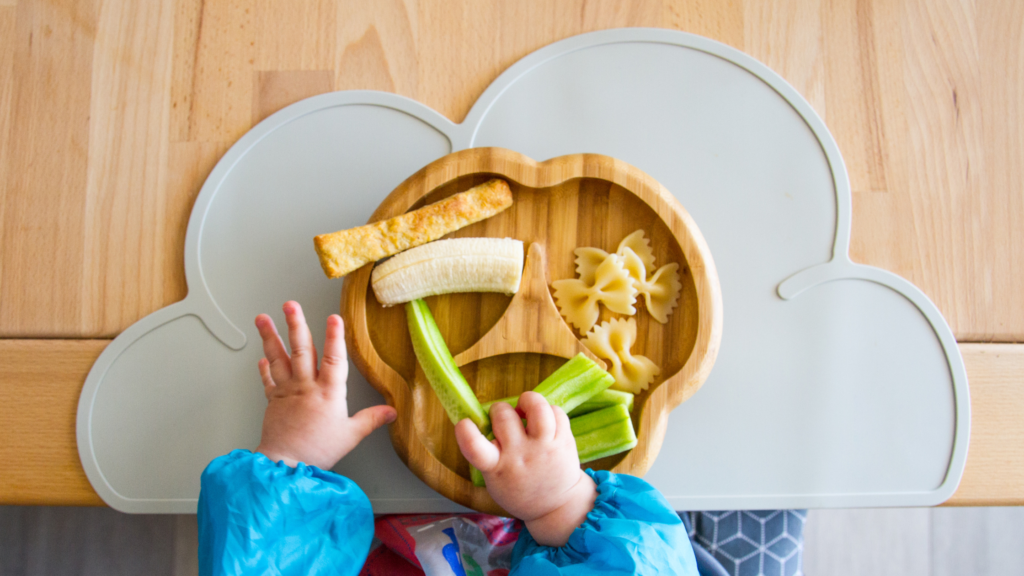
The most important thing? Let your baby lead and feed “responsively”
No matter which feeding method you choose, feeding your baby in a “responsive” way is what is most important. Responsive feeding is an attentive way of feeding your child, with the aim of recognizing their hunger and fullness cues so that you can respond in an appropriate and timely manner. This means allowing your baby to eat as much or as little as they choose, without coaxing them to eat more or taking food away before they have signaled that they are done. Honoring your baby’s natural instincts of hunger and fullness now will help them to continue to do so down the road!
| HUNGER CUES | FULLNESS CUES |
| – Reaches or points to food – Shows excitement when offered food – Opens mouth indicating they want a bite – Makes sounds or signs to indicate hunger – Verbally says “yes” or “more” |
– Slow paces of eating – Dodges or pushes spoon away – Turns head away – Clenches mouth shut – Playing with or throwing food – Shakes head no – Verbally says “no” or “all done” |
FAQ about baby-led weaning versus puress
A common concern is that baby will choke on solid foods and that purees are the safer option. While gagging may happen more frequently at the beginning of baby-led weaning, research actually shows that there is not a higher risk of choking when compared to traditional spoon feeding. It is important to note that gagging and choking are two different things. Gagging is extremely common when babies start solids, and should be, as it is a protective reflex that prevents larger pieces of food from reaching the windpipe. The gag reflex is essential in only allowing well-chewed pieces of food to the back of the throat to be swallowed. It helps prevent choking! Read Choking and Baby-Led Weaning: What You Need to Know for more tips to prevent choking when introducing solids to your little one.
It is important to prepare and serve your baby food in a way that is age-appropriate their developmental stage. At the beginning it is important to serve food at a soft enough texture that you can mash the piece of food with your tongue on the roof of your mouth. As your baby grows, the sizes and textures of foods that you can safely offer them expands! Every baby develops at a slightly different rate, so the key is to pay attention to the new skills that your little one is adding to their feeding capability as the weeks go on. They will start to develop more mature chewing and swallowing skills, followed by better finger dexterity and fine motor skills. You will notice as they grow, they will be able to pick up and bring smaller, firmer pieces of food to their mouth. Read tip number five in this comprehensive baby-led weaning blog for more detailed information on how to safely prepare protein foods, vegetables/fruits, grains/starches from month to month as your baby grows.
Conclusion
The first few weeks and months of introducing solids is special time for you and your baby. Enjoying food together at the table with your little one is an incredible bonding opportunity, and can be playful and fun! Eating newbies love to explore foods in a variety of ways including (but not limited to) smelling, touching, licking, mushing, and even tasting then spitting out food. It’s just their way of learning and exploring new foods and textures. Try not to be afraid to get a little messy! If your little one isn’t gobbling down everything right from the start, not to worry! It can take some babies longer to warm up to eating than others—and that is totally normal. Trust your gut as their parent to decide what method of introducing solids is best for your little one. Spoon feeding, baby-led weaning, or a combination…they all work! As long as you allow you little one to lead the way, pressure free!
Popular baby-led weaning recipes
References:
- Nutrition for Healthy Term Infants: Recommendations from Six to 24 Months – Canada.ca
- Food to Grow On: The Ultimate Guide to Kids Nutrition, from Pregnancy to Packed Lunches
